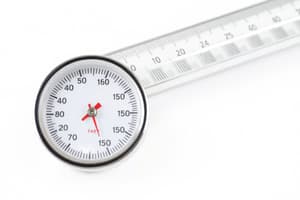Podcast
Questions and Answers
What is the primary purpose of the International Temperature Scale (ITS-90)?
What is the primary purpose of the International Temperature Scale (ITS-90)?
- To measure temperature based on the expansion of liquid in a glass tube
- To define the standards for medical electrical equipment
- To establish a standard for electronic thermometry in contact with liquid water or ice
- To provide a framework for calibrating temperature-measuring devices (correct)
Which type of thermometer is commonly used in laboratory settings?
Which type of thermometer is commonly used in laboratory settings?
- Liquid-in-Glass Thermometers (correct)
- Digital Thermometers
- Bimetallic strip Thermometers
- Filled System Thermometers
What is the principle behind Filled System Thermometers?
What is the principle behind Filled System Thermometers?
- Measuring temperature using electronic sensors
- Using a bimetallic strip to measure temperature
- Using a liquid-filled system to measure temperature (correct)
- Measuring temperature based on the expansion of liquid in a glass tube
Which standard guide is used for electronic thermometry in contact with liquid water or ice?
Which standard guide is used for electronic thermometry in contact with liquid water or ice?
What is the application of Digital Thermometers in medical settings?
What is the application of Digital Thermometers in medical settings?
What is the principle behind Liquid-in-Glass Thermometers?
What is the principle behind Liquid-in-Glass Thermometers?
Which standard defines requirements for non-invasive temperature sensors?
Which standard defines requirements for non-invasive temperature sensors?
What is the application of Filled System Thermometers in industrial processes?
What is the application of Filled System Thermometers in industrial processes?
What is the principle behind Bimetallic strip Thermometers?
What is the principle behind Bimetallic strip Thermometers?
What is the primary application of Radiation Thermometers?
What is the primary application of Radiation Thermometers?
What is the primary principle of operation of a bimetallic strip thermometer?
What is the primary principle of operation of a bimetallic strip thermometer?
Which type of thermometer is commonly used in industrial processes and aerospace applications?
Which type of thermometer is commonly used in industrial processes and aerospace applications?
What is the primary principle of operation of a radiation thermometer (pyrometer)?
What is the primary principle of operation of a radiation thermometer (pyrometer)?
What type of thermometer is used in medical devices and automotive applications?
What type of thermometer is used in medical devices and automotive applications?
What is the primary principle of operation of a pressure thermometer?
What is the primary principle of operation of a pressure thermometer?
What is the primary application of a single float method in liquid level measurement?
What is the primary application of a single float method in liquid level measurement?
What is the primary principle of operation of a displacement or force transducer in liquid level measurement?
What is the primary principle of operation of a displacement or force transducer in liquid level measurement?
What type of thermometer is commonly used in calibration standards and industrial processes?
What type of thermometer is commonly used in calibration standards and industrial processes?
What is the primary advantage of using thermocouples in temperature measurement?
What is the primary advantage of using thermocouples in temperature measurement?
What type of thermometer is used in precision temperature measurement and industrial processes?
What type of thermometer is used in precision temperature measurement and industrial processes?
What is the primary function of the transducer in a displacement or force transducer system?
What is the primary function of the transducer in a displacement or force transducer system?
In a pressure sensitivity system, what is the primary factor that affects the pressure reading at the bottom of the tank?
In a pressure sensitivity system, what is the primary factor that affects the pressure reading at the bottom of the tank?
What is the primary advantage of using a bubbler or page system for liquid level measurement?
What is the primary advantage of using a bubbler or page system for liquid level measurement?
What is the principle behind the capacitance variation type of liquid level measurement?
What is the principle behind the capacitance variation type of liquid level measurement?
What is the primary limitation of using a resistance variation type of liquid level measurement?
What is the primary limitation of using a resistance variation type of liquid level measurement?
What is the primary advantage of using a displacement or force transducer system for liquid level measurement?
What is the primary advantage of using a displacement or force transducer system for liquid level measurement?
What is the primary function of the air supply in a bubbler or page system?
What is the primary function of the air supply in a bubbler or page system?
What is the primary application of the capacitance variation type of liquid level measurement?
What is the primary application of the capacitance variation type of liquid level measurement?
What is the primary factor that affects the accuracy of a pressure sensitivity system?
What is the primary factor that affects the accuracy of a pressure sensitivity system?
What is the primary consideration when selecting a liquid level measurement method?
What is the primary consideration when selecting a liquid level measurement method?
Study Notes
Temperature Measurements
- International Temperature Scale (ITS-90): defines fixed points using reproducible temperatures for calibration.
- ASTM E2877-13: standard guide for electronic thermometry in contact with liquid water or ice.
- ISO 80601-2-56: standard for medical electrical equipment, defines requirements for non-invasive temperature sensors.
Temperature Measuring Devices
- Liquid-in-Glass Thermometers: measure temperature based on the expansion of liquid (usually mercury or alcohol) in a glass tube.
- Filled System Thermometers: use a liquid-filled system (e.g., gas-filled or liquid-filled bulb) to measure temperature.
- Digital Thermometers: measure temperature using electronic sensors (e.g., thermistors or RTDs) and display the result digitally.
- Bimetallic Strip Thermometers: two metals with different coefficients of thermal expansion bonded together, measure temperature changes by bending.
- Pressure Thermometers: use the relationship between pressure and temperature of a gas or vapor to determine temperature.
- Thermocouples: two dissimilar metals joined at one end, producing a voltage proportional to the temperature difference between the hot and cold junctions.
- Electrical Resistance Thermometers (RTDs): measure temperature based on the change in electrical resistance of a material (usually platinum or nickel) with temperature.
- Thermistors: semiconductor devices whose resistance changes significantly with temperature, with two types: NTC and PTC.
- Radiation Thermometers (Pyrometers): measure temperature by detecting the infrared radiation emitted by an object.
Liquid Level Measurements
- Single Float Method: measures liquid level by detecting the position of a float, simple and cost-effective.
- Displacement or Force Transducers: measures liquid level by detecting the displacement or force exerted by a submerged object.
- Pressure Sensitivity: measures liquid level by detecting the pressure at a specific point, which is proportional to the height of the liquid column.
- Bubbler or Page System: measures liquid level by detecting the pressure required to force gas bubbles through a submerged tube.
- Capacitance Variation Type: measures liquid level by detecting changes in capacitance between two electrodes, suitable for both conducting and non-conducting liquids.
- Resistance Variation Type: measures liquid level by detecting changes in resistance between electrodes, suitable for conductive liquids.
Studying That Suits You
Use AI to generate personalized quizzes and flashcards to suit your learning preferences.
Description
Test your knowledge on temperature measurements and devices, including international standards and technologies used in thermometry.




